Abstract
These investigations delineate the recently described suppression of a form of cellular hypersensitivity in mice with streptozotocin-induced diabetes mellitus using a variety of cell-mediated immunologic responses in animals with several different forms of diabetes. Streptozotocin- and alloxan-induced diabetic mice and db/db genetically determined diabetic mice showed reductions in the areas of inflammation around Schistosoma mansoni eggs injected into the pulmonary vasculature of 68, 70, 77%, respectively. In contrast, streptozotocin-induced diabetes had no effect on the nonimmunologic foreign body granuloma around divinyl benzene copolymer beads injected into the pulmonary arterioles. Animals protected from diabetes by treatment with nicotinamide before streptozotocin administration did not develop hyperglycemia and had normal areas of immunologic granuloma formation around schistosome eggs. Treatment with insulin reversed the suppression of schistosome egg granuloma formation in both streptozotocin- and alloxan-diabetic animals. Two additional in vivo parameters of cellular immunologic reactivity were examined in streptozotocin-induced diabetes: delayed footpad swelling was essentially eliminated; skin graft survival across the H-2 area was significantly prolonged from 10.2 days in the controls to 14.4 days in moderately diabetic A/J mice. These observations suggest that diabetes mellitus is associated with suppression of cell-mediated reactions in vivo and that the defect is reversible with insulin treatment.
Full text
PDF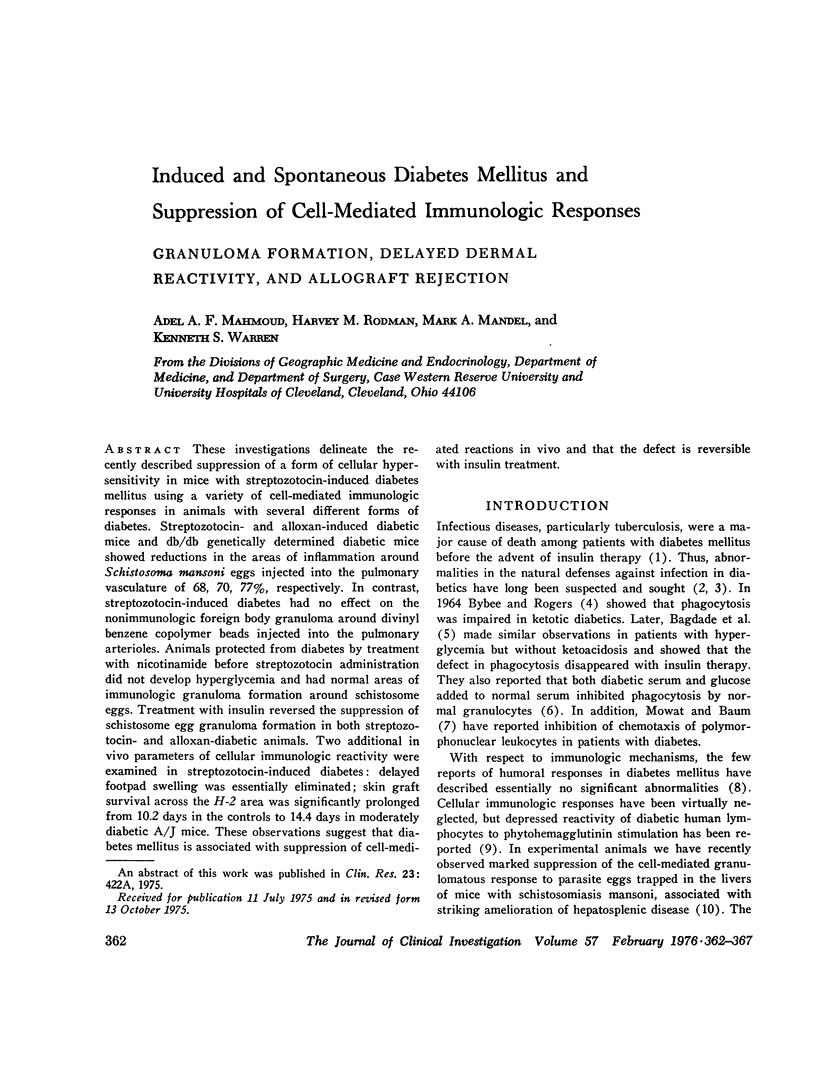
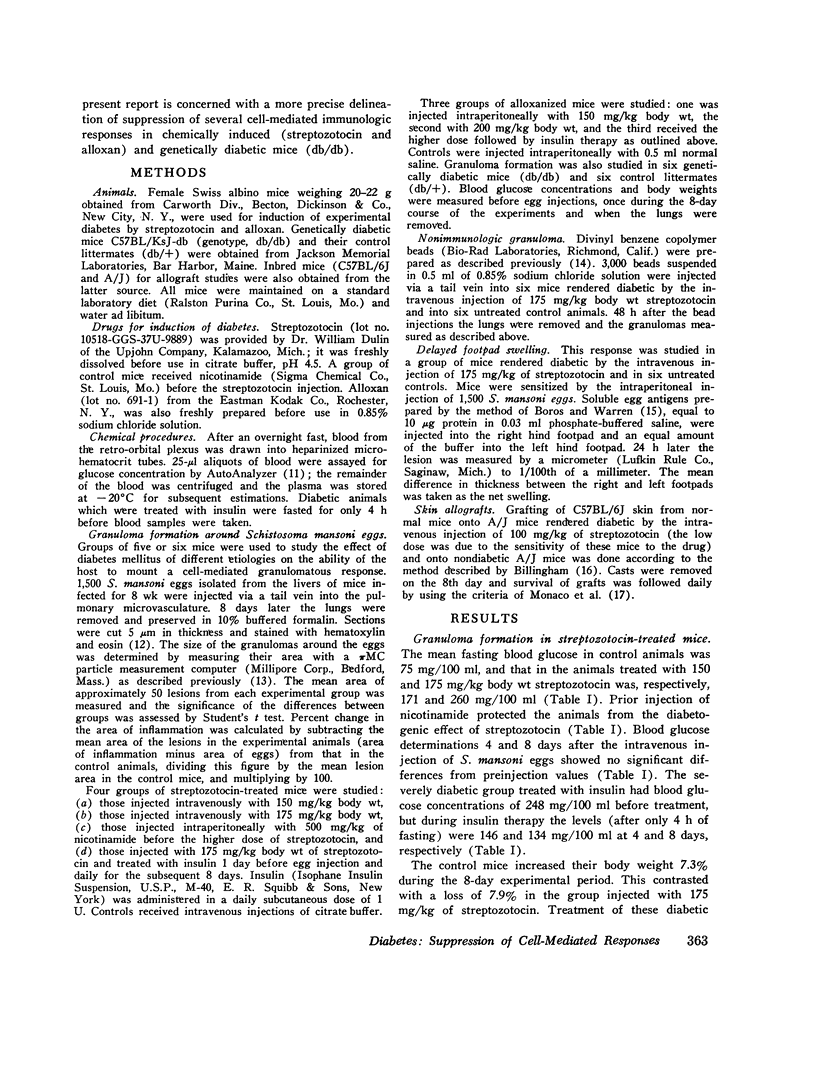
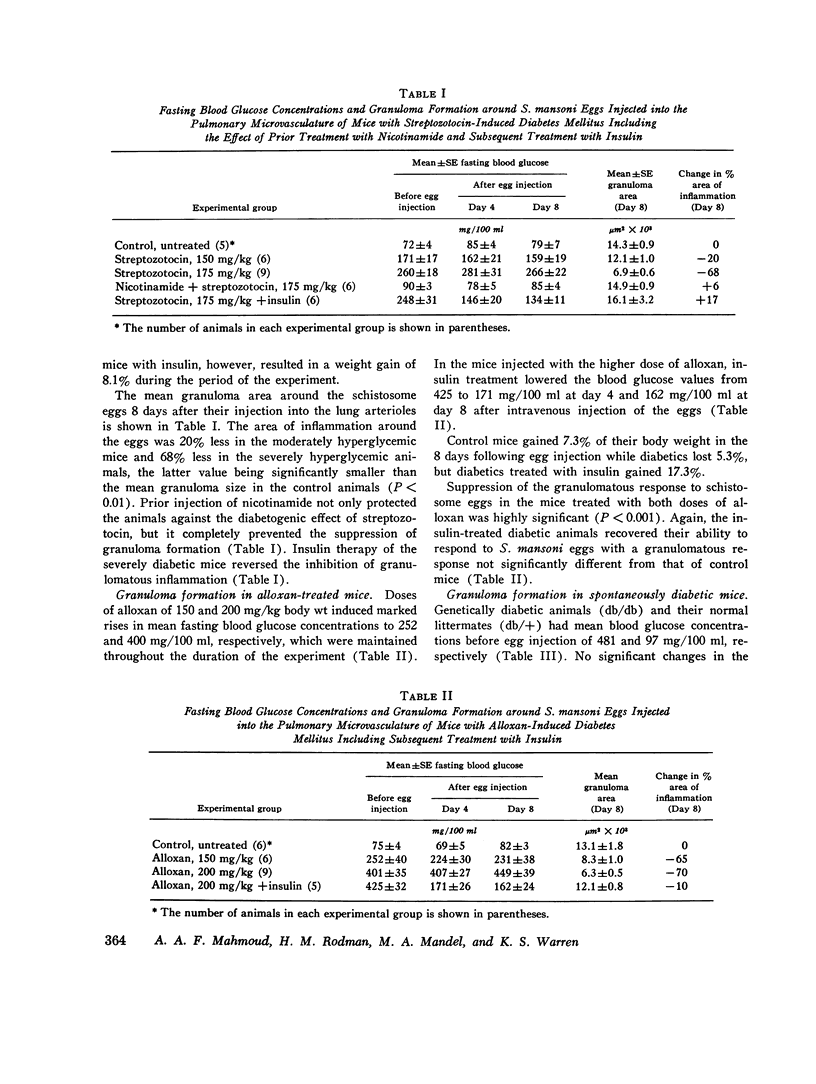
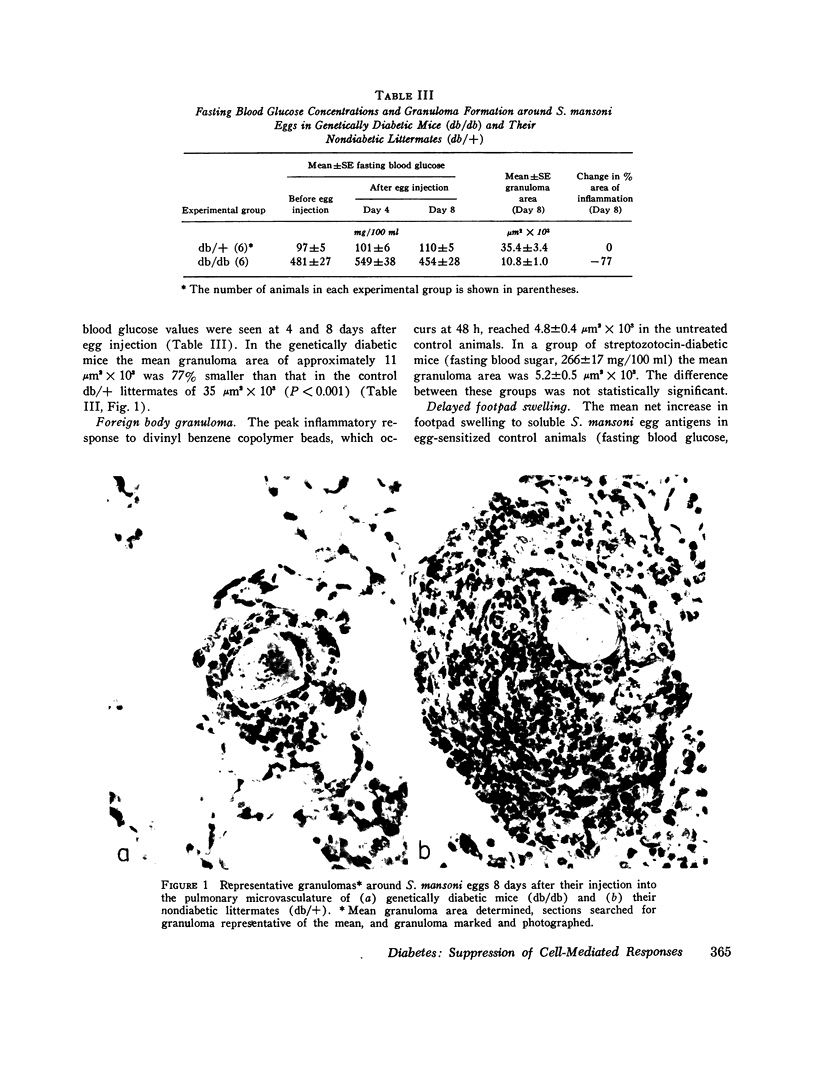
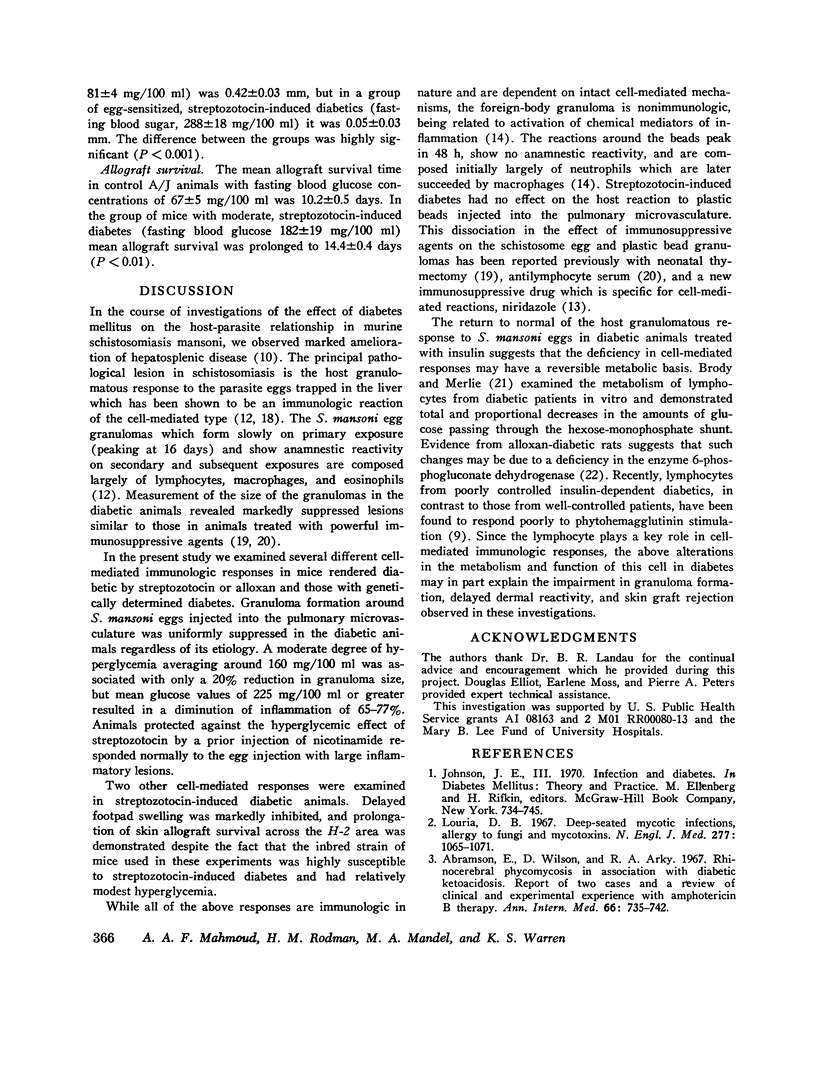
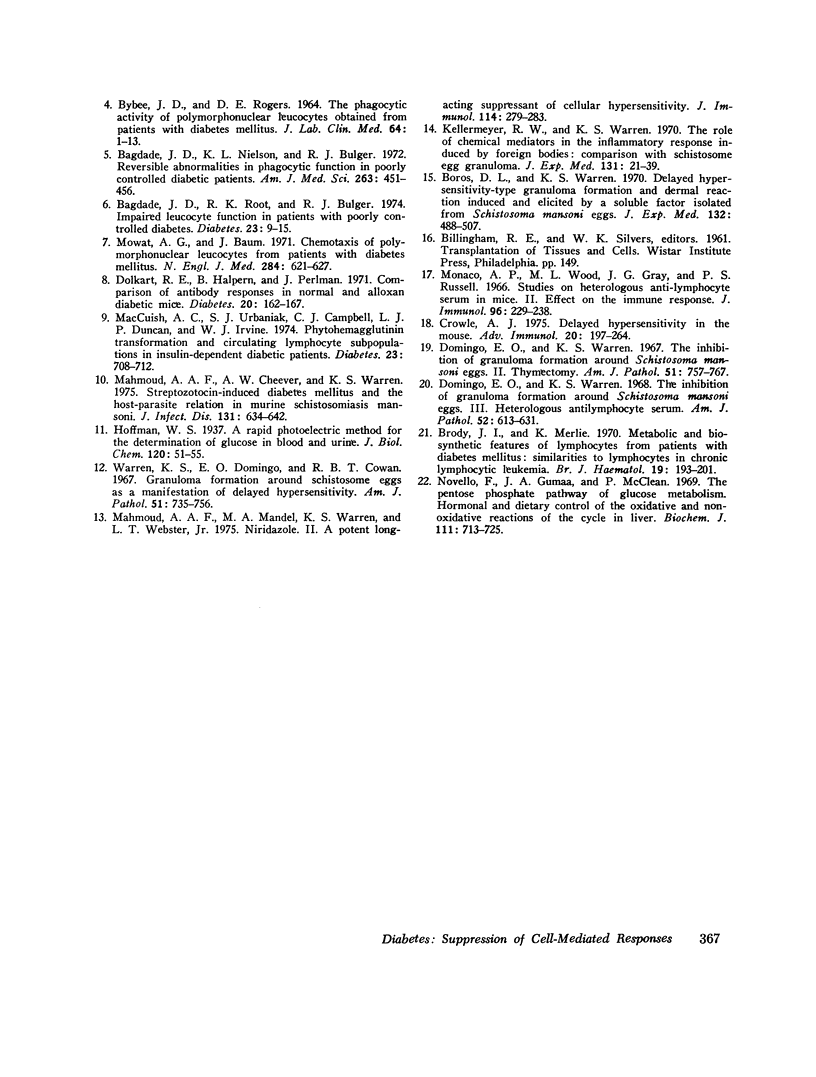
Images in this article
Selected References
These references are in PubMed. This may not be the complete list of references from this article.
- Abramson E., Wilson D., Arky R. A. Rhinocerebral phycomycosis in association with diabetic ketoacidosis. Report of two cases and a review of clinical and experimental experience with amphotericin B therapy. Ann Intern Med. 1967 Apr;66(4):735–742. doi: 10.7326/0003-4819-66-4-735. [DOI] [PubMed] [Google Scholar]
- BYBEE J. D., ROGERS D. E. THE PHAGOCYTIC ACTIVITY OF POLYMORPHONUCLEAR LEUKOCYTES OBTAINED FROM PATIENTS WITH DIABETES MELLITUS. J Lab Clin Med. 1964 Jul;64:1–13. [PubMed] [Google Scholar]
- Bagdade J. D., Nielson K. L., Bulger R. J. Reversible abnormalities in phagocytic function in poorly controlled diabetic patients. Am J Med Sci. 1972 Jun;263(6):451–456. doi: 10.1097/00000441-197206000-00005. [DOI] [PubMed] [Google Scholar]
- Bagdade J. D., Root R. K., Bulger R. J. Impaired leukocyte function in patients with poorly controlled diabetes. Diabetes. 1974 Jan;23(1):9–15. doi: 10.2337/diab.23.1.9. [DOI] [PubMed] [Google Scholar]
- Boros D. L., Warren K. S. Delayed hypersensitivity-type granuloma formation and dermal reaction induced and elicited by a soluble factor isolated from Schistosoma mansoni eggs. J Exp Med. 1970 Sep 1;132(3):488–507. doi: 10.1084/jem.132.3.488. [DOI] [PMC free article] [PubMed] [Google Scholar]
- Brody J. I., Merlie K. Metabolic and biosynthetic features of lymphocytes from patients with diabetes mellitus: similarities to lymphocytes in chronic lymphocytic leukaemia. Br J Haematol. 1970 Aug;19(2):193–201. doi: 10.1111/j.1365-2141.1970.tb01616.x. [DOI] [PubMed] [Google Scholar]
- Crowle A. J. Delayed hypersensitivity in the mouse. Adv Immunol. 1975;20:197–264. doi: 10.1016/s0065-2776(08)60209-6. [DOI] [PubMed] [Google Scholar]
- Domingo E. O., Warren K. S. The inhibition of granuloma formation around Schistosoma mansoni eggs. 3. Heterologous antilymphocyte serum. Am J Pathol. 1968 Mar;52(3):613–631. [PMC free article] [PubMed] [Google Scholar]
- Domingo E. O., Warren K. S. The inhibition of granuloma formation around Schistosoma mansoni eggs. II. Thymectomy. Am J Pathol. 1967 Nov;51(5):757–767. [PMC free article] [PubMed] [Google Scholar]
- Kellermeyer R. W., Warren K. S. The role of chemical mediators in the inflammatory response induced by foreign bodies: comparison with the schistosome egg granuloma. J Exp Med. 1970 Jan 1;131(1):21–39. doi: 10.1084/jem.131.1.21. [DOI] [PMC free article] [PubMed] [Google Scholar]
- Louria D. B. Deep-seated mycotic infections, allergy to fungi and mycotoxins. N Engl J Med. 1967 Nov 16;277(20):1065–contd. doi: 10.1056/NEJM196711162772005. [DOI] [PubMed] [Google Scholar]
- MacCuish A. C., Urbaniak S. J., Campbell C. J., Duncan L. J., Irvine W. J. Phytohemagglutinin transformation and circulating lymphocyte subpopulations in insulin-dependent diabetic patients. Diabetes. 1974 Aug;23(8):708–712. doi: 10.2337/diab.23.8.708. [DOI] [PubMed] [Google Scholar]
- Mahmoud A. A., Cheever A. W., Warren K. S. Streptozotocin-induced diabetes mellitus and the host-parasite relation in murine schistosomiasis mansoni. J Infect Dis. 1975 Jun;131(6):634–642. doi: 10.1093/infdis/131.6.634. [DOI] [PubMed] [Google Scholar]
- Mahmoud A. A., Mandel A., Warren K., Webster L. T., Jr Niridazole. II. A potent long-acting suppressant of cellular hypersensitivity. J Immunol. 1975 Jan;114(1 Pt 2):279–283. [PubMed] [Google Scholar]
- Monaco A. P., Wood M. L., Gray J. G., Russell P. S. Studies on heterologous anti-lymphocyte serum in mice. II. Effect on the immune response. J Immunol. 1966 Feb;96(2):229–238. [PubMed] [Google Scholar]
- Mowat A., Baum J. Chemotaxis of polymorphonuclear leukocytes from patients with diabetes mellitus. N Engl J Med. 1971 Mar 25;284(12):621–627. doi: 10.1056/NEJM197103252841201. [DOI] [PubMed] [Google Scholar]
- Novello F., Gumaa J. A., McLean P. The pentose phosphate pathway of glucose metabolism. Hormonal and dietary control of the oxidative and non-oxidative reactions of the cycle in liver. Biochem J. 1969 Mar;111(5):713–725. doi: 10.1042/bj1110713. [DOI] [PMC free article] [PubMed] [Google Scholar]
- Warren K. S., Domingo E. O., Cowan R. B. Granuloma formation around schistosome eggs as a manifestation of delayed hypersensitivity. Am J Pathol. 1967 Nov;51(5):735–756. [PMC free article] [PubMed] [Google Scholar]



